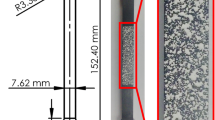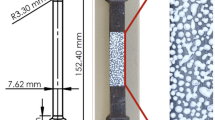Abstract
“Heat waves” is a colloquial term used to describe convective currents in air formed when different objects in an area are at different temperatures. In the context of Digital Image Correlation (DIC) and other optical-based image processing techniques, imaging an object of interest through heat waves can significantly distort the apparent location and shape of the object. There are many potential heat sources in DIC experiments, including but not limited to lights, cameras, hot ovens, and sunlight, yet error caused by heat waves is often overlooked. This paper first briefly presents three practical situations in which heat waves contributed significant error to DIC measurements to motivate the investigation of heat waves in more detail. Then the theoretical background of how light is refracted through heat waves is presented, and the effects of heat waves on displacements and strains computed from DIC are characterized in detail. Finally, different filtering methods are investigated to reduce the displacement and strain errors caused by imaging through heat waves. The overarching conclusions from this work are that errors caused by heat waves are significantly higher than typical noise floors for DIC measurements, and that the errors are difficult to filter because the temporal and spatial frequencies of the errors are in the same range as those of typical signals of interest. Therefore, eliminating or mitigating the effects of heat sources in a DIC experiment is the best solution to minimizing errors caused by heat waves.































Similar content being viewed by others
Notes
Displacement error caused by heat waves is able to be separated from displacement errors caused by mirror motion or window distortion based on characteristics of the errors associated with each error source. Mirror motion induces rigid-body displacements, not spatially-varying displacements like those caused by heat waves. A window will only cause displacement error if a sample is translated, but in this data, the sample remained stationary; additionally, distortions caused by windows would be stationary over time, whereas the errors caused by heat waves change as a function of time.
The following conditions for the air were used in this approximation: wavelength of light of 532 nm, fractional humidity of 0.1, carbon dioxide content in air of 450 ppm, total air pressure of 101.325 kPa.
In brief, the Multi-System feature correlates the reference images from one stereo system to the reference images of a second stereo system and, using the calibrations of each stereo system, computes the coordinate transformation that best aligns the coordinate systems from the two stereo systems.
Some factors include temperature of the heat source, location of the heat source (“Location of heat source”), stand-off distance / lens focal length (“Focal length and stand-off distance”), and environmental conditions (i.e. room or outside air flow)
References
Sutton MA, Orteu JJ, Schrier H (2009) Image correlation for shape, motion and deformation measurements: basic concepts, theory and applications. Springer, USA
Boyce BL, Reu PL, Robino CV (2006) The constitutive behavior of laser welds in 304l stainless steel determined by digital image correlation. Metall Mater Trans A 37A:2481–2492
Gilat A, Schmidt TE, Walker AL (2009) Full field strain measurement in compression and tensile split hopkinson bar experiments. Exp Mech 49:291–302
Zhang D, Arola DD (2004) Applications of digital image correlation to biological tissues. J Biomed Opt 9 (4):691–699
Lionello G, Sirieix C, Baleani M (2014) An effective procedure to create a speckle pattern on biological soft tissue for digital image correlation measurements. J Mech Behav Biomed Mater 39:1–8
Jones EMC, Çapraz ÖÖ, White SR, Sottos NR (2016) Reversible and irreversible deformation mechanisms of composite graphite electrodes in lithium-ion batteries. J Electrochem Soc 163(9):A1965–A1974
Chen J, Thapa AK, Berfield TA (2014) In-situ characterization of strain in lithium battery working electrodes. J Power Sources 271:406–413
Cooper MA, Reu PL, Miller TJ (2010) Observations in explosive systems with high-speed digital image correlation. In: 14th international detonation symposium
Reu PL, Miller TJ (2008) The application of high-speed digital image correlation. J Strain Anal Eng 43 (8):673–688
Beberniss TJ, Ehrhardt DA (2016) High-speed 3d digital image correlation vibration measurement: Recent advancements and noted limitations. Mech Syst Signal Pr 86:35–48
Lyons JS, Liu J, Sutton MA (1996) High-temperature deformation measurements using digital image correlation. Exp Mech 36(1):64–70
Raffel M (2015) Background-oriented schlieren (bos) techniques. Exp Fluids 56(60):1–17
Dalziel SB, Hughes GO, Sutherland BR (2000) Whole-field density measurements by ‘synthetic schlieren’. Exp Fluids 28:322–335
Richard H, Raffel M (2001) Principle and applications of the background oriented schlieren (bos) method. Meas Sci Technol 12:1576–1585
van Hinsberg NP, Rösgen T (2014) Density measurements using near-field background-oriented schlieren. Exp Fluids 55(1720): 1–11
Ciddor PE (1996) Refractive index of air: new equations for the visible and near infrared. Appl Optics 35 (9):1566–1573
Stone JA, Zimmerman JH (2011) Index of refraction of air. http://emtoolbox.nist.gov/Wavelength/Documentation.asp. Accessed Mar 2017
Schreier HW, Braasch JR, Sutton MA (2000) Systematic errors in digital image correlation caused by intensity interpolation. Opt Eng 39(11):2915–2921
Baldi A, Bertolino F (2015) Experimental analysis of the errors due to polynomial interpolation in digital image correlation. Strain 51(3):248–263
Reu PL (2012) The art and application of dic: stereo-rig design: creating the stereo-rig layout - part 1. Exp Tech 36(5):3–4
Sparrow EM, Husar RB, Goldstein RJ (1970) Observations and other characteristics of thermals. J Fluid Mech 41(4):793–800
Novak MD, Zok FW (2011) High-temperature materials testing with full-field strain measurement: experimental design and practice. Rev Sci Instrum 82:115101
Delmas A, Le Maoult Y, Buchlin J-M, Sentenac T, Orteu J-J (2013) Shape distortions induced by convective effect on hot object in visible, near infrared, and infrared bands. Exp Fluids 55(1452):1–16
Acknowledgments
The authors acknowledge interns TDaniel Barnhouse, Taylor Spencer, Carl Stahoviak, and Hailey Stock, for their assistance in collecting and analyzing data for the multi-DIC system experiment. Sandia National Laboratories is a multimission laboratory managed and operated by National Technology and Engineering Solutions of Sandia, LLC., a wholly owned subsidiary of Honeywell International, Inc., for the U.S. Department of Energy’s National Nuclear Security Administration under contract DE-NA-0003525.
Author information
Authors and Affiliations
Corresponding author
Electronic supplementary material
Below is the link to the electronic supplementary material.
Rights and permissions
About this article
Cite this article
Jones, E., Reu, P. Distortion of Digital Image Correlation (DIC) Displacements and Strains from Heat Waves. Exp Mech 58, 1133–1156 (2018). https://doi.org/10.1007/s11340-017-0354-3
Received:
Accepted:
Published:
Issue Date:
DOI: https://doi.org/10.1007/s11340-017-0354-3




